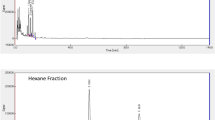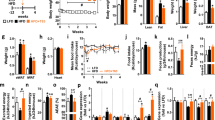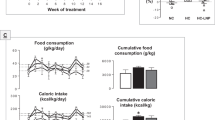Abstract
OBJECTIVE:
To investigate how and to what extent platycodin saponin (PS) from Platycodi Radix exerts a favorable influence on obesity and hyperlipidemia.
DESIGN:
Sprague–Dawley rats were fed with a high fat (HF) diet for 4 weeks and then the animals were treated with 35 or 70 mg / kg of PS for another 4 weeks. Changes in body weight and daily calorie intake were measured regularly during the experimental period and the degree of linear correlation for the above two variables was further analyzed. The in vitro lipase inhibition of each PS compound and the in vivo fecal lipid excretion were examined in hope of revealing their relationship. The concentrations of hepatic triglyceride and cholesterol in serum.
RESULTS:
The body weight reduction (13±4% vs HF control, P<0.05) by PS administration was highly correlated to the food intake restriction (Pearson's linear coefficient r=0.752, P<0.005). The in vitro inhibition of lipase by each isolated compound and mixture of PS were virtually identical. Consequently, the fecal TG excretion was increased by 2.1–3.2 folds depending on the dose of PS. The serum TG and LDL-cholesterol concentrations were decreased without noticeable changes in HDL-cholesterol levels. Concomitantly, the contents of the hepatic TG, cholesterol, and the liver surface fat pads were decreased in ubiquity, but no noticeable biochemical abnormalities or histological tissue damages were observed.
CONCLUSIONS:
The administration of PS produced profound effects on the control of obesity and lipid metabolism, which resulted in LDL-cholesterol reduction. PS also caused a remarkable reduction in calorie intake, which was highly correlated to the body weight loss. These results suggest that PS has a greater role in antiobesity, hypolipidemia, and liver protection than previously thought. Hence, PS could be a potential therapeutic alternative in the treatment of obesity and hyperlipidemia.
This is a preview of subscription content, access via your institution
Access options
Subscribe to this journal
Receive 12 print issues and online access
$259.00 per year
only $21.58 per issue
Buy this article
- Purchase on Springer Link
- Instant access to full article PDF
Prices may be subject to local taxes which are calculated during checkout





Similar content being viewed by others
References
Han LK, Xu BJ, Kimura Y, Zheng Y, Okuda H . Platycodi radix affects lipid metabolism in mice with high fat diet-induced obesity. J Nutr 2000; 130: 2760–2764.
Han LK, Zheng YN, Xu BJ, Okuda H, Kimura Y . Saponins from platycodi radix ameliorate high fat diet-induced obesity in mice. J Nutr 2002; 132: 2241–2245.
Yamamoto M, Shimura S, Itoh Y, Ohsaka T, Egawa M, Inoue S . Anti-obesity effects of lipase inhibitor CT-II, an extract from edible herbs, Nomame Herba, on rats fed a high-fat diet. Int J Obes Relat Metab Disord 2000; 24: 758–764.
Sternby B, Hartmann D, Borgstrom B, Nilsson A . Degree of in vivo inhibition of human gastric pancreatic lipases by Orlistat (Tetrahydrolipstatin, THL) in the stomach small intestine. Clin Nutr 2002; 21: 395–402.
Murase T, Nagasawa A, Suzuki J, Hase T, Tokimitsu I . Beneficial effects of tea catechins on diet-induced obesity: stimulation of lipid catabolism in the liver. Int J Obes Relat Metab Disord 2002; 26: 1459–1464.
Lolmede K, Dur de Saint Front V, Galitzky J, Lafontan M, Bouloumie A . Effects of hypoxia on the expression of proangiogenic factors in differentiated 3T3-F442A adipocytes. Int J Obes Relat Metab Disord 2003; 27: 1187–1195.
Hiroahi I, Kauzuo T, Yohko Y . Saponins from the roots of Platycodon grandiflorum. Part 1: structure of prosapogenins. J Chem Soc Perkin Trans I 1981; 1928–1933.
Hiroashi I, Kauzuo T, Takehiko T, Yohko Y . Saponins from roots of Platycodon grandiflorum. Part 2: Isolation and structure of new triterpene glycosides. J Chem Soc Perkin Trans I 1984; 661–668.
Choi CY, Kim JY, Kim YS, Chung YC, Hahm KS, Jeong HG . Augmentation of macrophage functions by an aqueous extract isolated from Platycodon grandiflorum. Cancer Lett 2001; 166: 17–25.
Choi CY, Kim JY, Kim YS, Chung YC, Seo JK, Jeong HG . Aqueous extract isolated from Platycodon grandiflorum elicits the release of nitric oxide and tumor necrosis factor-α from murine macrophages. Int Immunopharmacol 2001; 1: 1141–1151.
Kim YP, Lee EB, Kim SY, Li DW, Ban HS, Lim SS, Shin KH, Ohuchi K . Inhibition of prostaglandin E2 production by platycodin D isolated from the root of Platycodon grandiflorum. Planta Med 2001; 67: 362–364.
Levin BE, Dunn-Meynell AA, McMinn JE, Alperovich M, Cunningham-Bussel A, Chua Jr SC . A new obesity-prone, glucose-intolerant rat strain (F.DIO). Am J Physiol Regul Integr Comp Physiol 2003; 285: R1184–R1191.
Seoul National University Environmental Safety Institute. Experiment Safety Guidelines. Seoul National University, 3rd edn. Dongwha Press: Seoul; 2003.
Folch J, Ascoli I, Lees M, Meath JA, Le BN . Preparation of lipid extracts from brain tissue. J Biol Chem 1951; 191: 833–841.
Friedewald WT, Levy RI, Fredrickson DS . Estimation of the concentration of low-density lipoprotein cholesterol in plasma without use of the preparative ultracentrifuge. Clin Chem 1972; 28: 499–502.
Imamura S, Hirayama T, Arai T, Takao K, Misaki H . An enzymatic method using 1, 2-diglyceride for pancreatic lipase test in serum. Clin Chem 1989; 35: 1126–1132.
Zhao HL, Kim YS . Determination of the kinetic properties of platycodin D for the inhibition of pancreatic lipase using a 1, 2-diglyceride-based colorimetric assay. Arch Pharm Res 2004; 27: 968–972.
Heck AM, Yanovski JA, Calis KA . Orlistat, a new lipase inhibitor for the management of obesity. Pharmacotherapy 2000; 20: 270–279.
Morehouse LA, Bangerter FW, DeNinno MP, Inskeep PB, McCarthy PA, Pettini JL, Savoy YE, Sugarman ED, Wilkins RW, Wilson TC, Woody HA, Zaccaro LM, Chandler CE . Comparison of synthetic saponin cholesterol absorption inhibitors in rabbits: evidence for a non-stoichiometric, intestinal mechanism of action. J Lipid Res 1999; 40: 464–474.
Uusitupa M . New aspects in the management of obesity: operation and the impact of lipase inhibitors. Curr Opin Lipidol 1999; 10: 3–7.
Drent ML, Van der Veen EA . Lipase inhibition: a novel concept in the treatment of obesity. Int J Obes Relat Metab Disord 1993; 17: 241–244.
Mathur R, Sharma A, Dixit VP, Varma M . Hypolipidaemic effect of fruit juice of Emblica officinalis in cholesterol-fed rabbits. J Ethnopharmacol 1996; 50: 61–68.
Hollander PA, Elbein SC, Hirsch IB, Kelley D, McGill J, Taylor T, Weiss SR, Crockett SE, Kaplan RA, Comstock J, Lucas CP, Lodewick PA, Canovatchel W, Chung J, Hauptman J . Role of orlistat in the treatment of obese patients with type 2 diabetes: a 1-year randomized double-blind study. Diabetes Care 1998; 21: 1288–1294.
Keating GM, Jarvis B . Orlistat: in the prevention and treatment of type 2 diabetes mellitus. Drugs 2001; 61: 2107–2121.
Lee EB . Pharmacological activities of crude platycodin. J Pharmaceut Soc Korea 1975; 19: 164–176.
Acknowledgements
We thank Mr Joo Min Kim of Shin Chon Feed Co. Ltd for his kind donation of chow materials for the high fat diet and his instructions on the animal nutrition. The authentic samples of platycodin saponins were generously donated by Professor Eun Bang Lee of Natural Products Research Institute, Seoul National University. This work was supported by a grant of the Korea Health 21 R&D Project, Ministry of Health & Welfare, Republic of Korea (HMP-01-PJ2-PG6-01NA01-002).
Author information
Authors and Affiliations
Corresponding author
Additional information
Supplementary information accompanies the paper on International Journal of Obesity website (http://www.nature.com/ijo).
Supplementary information
Rights and permissions
About this article
Cite this article
Zhao, H., Sim, JS., Shim, S. et al. Antiobese and hypolipidemic effects of platycodin saponins in diet-induced obese rats: evidences for lipase inhibition and calorie intake restriction. Int J Obes 29, 983–990 (2005). https://doi.org/10.1038/sj.ijo.0802948
Received:
Revised:
Accepted:
Published:
Issue Date:
DOI: https://doi.org/10.1038/sj.ijo.0802948
Keywords
This article is cited by
-
Evaluation of anti-obesity potential of aqueous extract of Achyranthes aspera Linn. in high fat diet induced obese rats
Clinical Phytoscience (2020)
-
Kojic acid repurposing as a pancreatic lipase inhibitor and the optimization of its production from a local Aspergillus oryzae soil isolate
BMC Biotechnology (2020)
-
Platycodin D enhances LDLR expression and LDL uptake via down-regulation of IDOL mRNA in hepatic cells
Scientific Reports (2020)
-
Hypothalamus-pituitary-adrenal Axis in Glucolipid metabolic disorders
Reviews in Endocrine and Metabolic Disorders (2020)
-
Impromptu Effects of Nt8U with Soyasaponins on Obesity-related Lipid Parameters in High Fat Fed C57BL/6 Mice
International Journal of Peptide Research and Therapeutics (2020)



